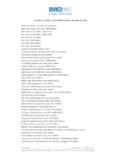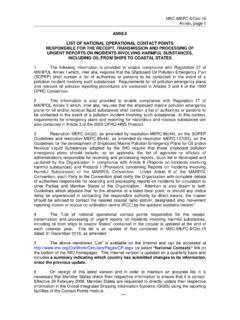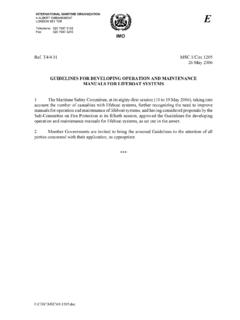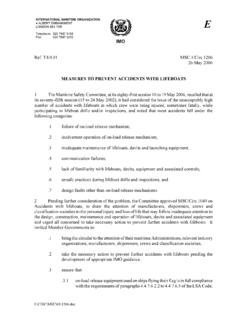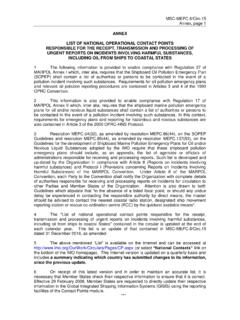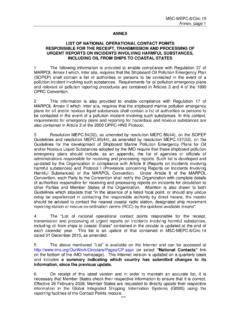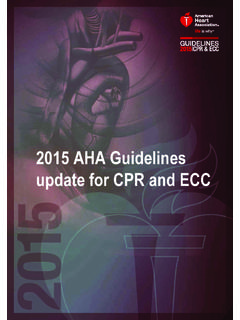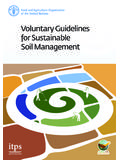Transcription of RESOLUTION MEPC.269(68) Adopted on 15 May 2015 2015 ...
1 RESOLUTION (68). Adopted on 15 May 2015 . 2015 guidelines FOR THE development OF. THE inventory OF hazardous MATERIALS. RESOLUTION (68). Adopted on 15 May 2015 . 2015 guidelines FOR THE development OF. THE inventory OF hazardous MATERIALS MEPC 68/21 Annex 17, page 1. ANNEX 17. RESOLUTION (68). ( Adopted on 15 May 2015 ). 2015 guidelines FOR THE development OF THE. inventory OF hazardous MATERIALS. THE MARINE ENVIRONMENT PROTECTION COMMITTEE, RECALLING Article 38(a) of the Convention on the International Maritime Organization concerning the functions of the Marine Environment Protection Committee conferred upon it by international conventions for the prevention and control of marine pollution from ships, RECALLING ALSO that the International Conference on the Safe and Environmentally Sound Recycling of Ships held in May 2009 Adopted the Hong Kong International Convention for the Safe and Environmentally Sound Recycling of Ships, 2009 (the Hong Kong Convention)
2 Together with six Conference resolutions, NOTING that regulations and of the annex to the Hong Kong Convention require that ships shall have on board an inventory of hazardous Materials which shall be prepared and verified taking into account guidelines , including any threshold values and exemptions contained in those guidelines , developed by the Organization, NOTING ALSO RESOLUTION (62) by which it Adopted guidelines for the development of the inventory of hazardous Materials (the guidelines ) and resolved to keep them under review, RECOGNIZING the need to improve the guidance on threshold values and exemptions, as contained in the aforementioned guidelines , HAVING CONSIDERED, at its sixty-eighth session, the recommendation made by the Sub-Committee on Pollution Prevention and Response, at its second session, 1 ADOPTS the 2015 guidelines for the development of the inventory of hazardous Materials as set out in the annex to this RESOLUTION .
3 2 INVITES Member Governments to apply the 2015 guidelines as soon as possible, or latest when the Convention enters into force;. 3 AGREES to keep the 2015 guidelines under review in the light of experience gained with their application;. 4 SUPERSEDES the guidelines Adopted by RESOLUTION (62). Documents/English/MEPC (E).doc RESOLUTION (68). Adopted on 15 May 2015 . 2015 guidelines FOR THE development OF. MEPC 68/21 THE inventory OF hazardous MATERIALS. Annex 17, page 2. ANNEX. 2015 guidelines FOR THE development OF THE. inventory OF hazardous MATERIALS. 1 INTRODUCTION. Objectives These guidelines provide recommendations for developing the inventory of hazardous Materials (hereinafter referred to as "the inventory " or "the IHM") to assist compliance with regulation 5 ( inventory of hazardous Materials) of the Hong Kong International Convention for the Safe and Environmentally Sound Recycling of Ships, 2009 (hereinafter referred to as "the Convention").
4 Application These guidelines have been developed to provide relevant stakeholders ( shipbuilders, equipment suppliers, repairers, shipowners and ship management companies) with the essential requirements for the practical and logical development of the inventory . Objectives The objectives of the inventory are to provide ship-specific information on the actual hazardous materials present on board, in order to protect health and safety and to prevent environmental pollution at ship recycling facilities. This information will be used by the ship recycling facilities in order to decide how to manage the types and amounts of materials identified in the inventory of hazardous Materials (regulation 9 of the Convention). 2 DEFINITIONS. The terms used in these guidelines have the same meaning as those defined in the Convention, with the following additional definitions which apply to these guidelines only.
5 Exemption (as referred to in regulation 5 of the Convention) means materials specified in paragraph in these guidelines that do not need to be listed on the IHM, even if such materials or items exceed the IHM threshold values. Fixed means the conditions that equipment or materials are securely fitted with the ship, such as by welding or with bolts, riveted or cemented, and used at their position, including electrical cables and gaskets. Homogeneous material means a material of uniform composition throughout that cannot be mechanically disjointed into different materials, meaning that the materials cannot, in principle, be separated by mechanical actions such as unscrewing, cutting, crushing, grinding and abrasive processes. Loosely fitted equipment means equipment or materials present on board the ship by the conditions other than "fixed", such as fire extinguishers, distress flares, and lifebuoys.
6 Product means machinery, equipment, materials and applied coatings on board a ship. Documents/English/MEPC (E).doc RESOLUTION (68). Adopted on 15 May 2015 . 2015 guidelines FOR THE development OF. THE inventory OF hazardous MATERIALS MEPC 68/21 Annex 17, page 3. Supplier means a company which provides products; which may be a manufacturer, trader or agency. Supply chain means the series of entities involved in the supply and purchase of materials and goods, from raw materials to final product. Threshold value is defined as the concentration value in homogeneous materials. 3 REQUIREMENTS FOR THE inventory . Scope of the inventory The inventory consists of: Part I: Materials contained in ship structure or equipment;. Part II: Operationally generated wastes; and Part III: Stores. Materials to be listed in the inventory Appendix 1 of these guidelines (Items to be listed in the inventory of hazardous Materials), provides information on the hazardous materials that may be found on board a ship.
7 Materials set out in appendix 1 should be listed in the inventory . Each item in appendix 1 of these guidelines is classified under tables A, B, C or D, according to its properties: .1 table A comprises the materials listed in appendix 1 of the Convention;..2 table B comprises the materials listed in appendix 2 of the Convention;..3 table C (Potentially hazardous items) comprises items which are potentially hazardous to the environment and human health at ship recycling facilities;. and .4 table D (Regular consumable goods potentially containing hazardous materials) comprises goods which are not integral to a ship and are unlikely to be dismantled or treated at a ship recycling facility. Tables A and B correspond to part I of the inventory . Table C corresponds to parts II. and III and table D corresponds to part III.
8 For loosely fitted equipment, there is no need to list this in part I of the inventory . Such equipment which remains on board when the ship is recycled should be listed in part III. Those batteries containing lead acid or other hazardous materials that are fixed in place should be listed in part I of the inventory . Batteries that are loosely fitted, which includes consumer batteries and batteries in stores, should be listed in part III of the inventory . Documents/English/MEPC (E).doc RESOLUTION (68). Adopted on 15 May 2015 . 2015 guidelines FOR THE development OF. MEPC 68/21 THE inventory OF hazardous MATERIALS. Annex 17, page 4. Similar materials or items that contain hazardous materials that potentially exceed the threshold value can be listed together (not individually) on the IHM with their general location and approximate amount specified there (hereinafter referred to as "bulk listing").
9 An example of how to list those materials and items is shown in row 3 of table 1 of appendix 3. Exemptions Materials not required to be listed in the inventory Materials listed in Table B that are inherent in solid metals or metal alloys, such as steels, aluminium, brasses, bronzes, plating and solders, provided they are used in general construction, such as hull, superstructure, pipes or housings for equipment and machinery, are not required to be listed in the inventory . Although electrical and electronic equipment is required to be listed in the inventory , the amount of hazardous materials potentially contained in printed wiring boards (printed circuit boards) installed in the equipment does not need to be reported in the inventory . Standard format of the inventory of hazardous Materials The inventory should be developed on the basis of the standard format set out in appendix 2.
10 Of these guidelines : Standard format of the inventory of hazardous Materials. Examples of how to complete the inventory are provided for guidance purposes only. Revision to threshold values Revised threshold values in tables A and B of appendix 1 should be used for IHMs developed or updated after the adoption of the revised values and need not be applied to existing IHMs and IHMs under development . However, when materials are added to the IHM, such as during maintenance, the revised threshold values should be applied and recorded in the IHM. 4 REQUIREMENTS FOR development OF THE inventory . development of part I of the inventory for new ships1. Part I of the inventory for new ships should be developed at the design and construction stage. Checking of materials listed in table A. During the development of the inventory (part I), the presence of materials listed in table A of appendix 1 should be checked and confirmed; the quantity and location of table A materials should be listed in part I of the inventory .


